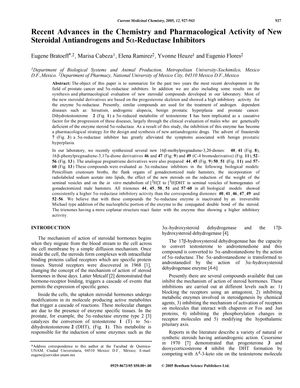Recent Advances in the Chemistry and Pharmacological Activity of New Steroidal Antiandrogens and 5α-Reductase Inhibitors
March 2005
in “
Current Medicinal Chemistry
”
steroidal antiandrogens 5α-reductase inhibitors androgenic alopecia benign prostatic hyperplasia prostate cancer progesterone derivatives trienone derivatives dienones Michael type addition reaction enzyme inactivation finasteride dutasteride enzyme inhibition potency enzyme selectivity human 5α-reductase nonsteroidal antiandrogens flutamide bicalutamide phytopharmaceuticals saw palmetto β-sitosterol Propecia Avodart beta-sitosterol

TLDR New compounds show promise for treating hair loss, enlarged prostate, and prostate cancer, with some being more effective and having different side effects than current treatments.
The document from 2005 explores the development of new steroidal antiandrogens and 5α-reductase inhibitors, which are important for treating conditions such as androgenic alopecia, benign prostatic hyperplasia, and prostate cancer. It details the synthesis of new compounds with high inhibitory activity against 5α-reductase, particularly focusing on derivatives based on the progesterone skeleton. The study found that trienone derivatives were more effective than dienones, suggesting a Michael type addition reaction mechanism for enzyme inactivation. The document also compares the efficacy and side effects of existing treatments like finasteride, a 5α-reductase inhibitor used for benign prostatic hyperplasia and male pattern baldness, and discusses the potential of dual inhibitors like dutasteride, which was awaiting FDA approval. It highlights the importance of enzyme inhibition potency and selectivity, and the need for further research using human 5α-reductase expressed in transfected cells or native human tissues, as animal models may not provide directly applicable data. The document also mentions the limited benefits and adverse effects of nonsteroidal antiandrogens like flutamide and bicalutamide, and the controversial efficacy of phytopharmaceuticals like saw palmetto and β-sitosterol. The specific number of people or subjects involved in the study was not mentioned in the provided text.




